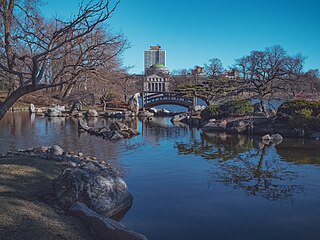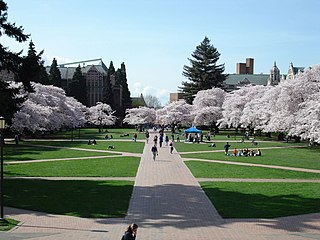Related Research Articles

A cherry is the fruit of many plants of the genus Prunus, and is a fleshy drupe.

The cherry blossom, or sakura, is the flower of trees in Prunus subgenus Cerasus. Sakura usually refers to flowers of ornamental cherry trees, such as cultivars of Prunus serrulata, not trees grown for their fruit. Cherry blossoms have been described as having a vanilla-like smell, which is mainly attributed to coumarin.

Hanami is the Japanese traditional custom of enjoying the transient beauty of flowers; flowers in this case almost always refer to those of the cherry or, less frequently, plum trees. From the end of March to early May, cherry trees bloom all over Japan, and around the second week of January on the island of Okinawa. The blossom forecast "cherry blossom front" is announced each year by the Japan Meteorological Agency and watched carefully by those planning hanami, as the blossoms only last a week or two.

West Potomac Park is a U.S. national park in Washington, D.C., adjacent to the National Mall. It includes the parkland that extends south of the Lincoln Memorial Reflecting Pool, from the Lincoln Memorial to the grounds of the Washington Monument. The park is the site of several national landmarks including the Korean War Veterans Memorial, Jefferson Memorial, Franklin Delano Roosevelt Memorial, George Mason Memorial, and the Martin Luther King Jr. Memorial.

The National Cherry Blossom Festival is a spring celebration in Washington, D.C., commemorating the March 27, 1912, gift of Japanese cherry trees from Mayor Yukio Ozaki of Tokyo City to the city of Washington, D.C. Ozaki gave the trees to enhance the growing friendship between the United States and Japan and also celebrate the continued close relationship between the two nations. Large and colorful helium balloons, floats, marching bands from across the country, music and showmanship are parts of the Festival's parade and other events.

Prunus serrulata or Japanese cherry is a species of cherry tree that grows naturally in Japan, China, Korea, and Vietnam, and it also refers to a cultivar produced from Prunus speciosa, a cherry tree endemic in Japan. Historically, the Japanese have developed many cultivars by selective breeding of cherry trees, which are produced by the complicated crossing of several wild species, and they are used for ornamental purposes all over the world. Of these, the cultivars produced by complex interspecific hybrids based on the Oshima cherry are also known as the Cerasus Sato-zakura Group.

Kairaku-en is a Japanese garden located in Mito, Ibaraki Prefecture, Japan. Along with Kenroku-en and Koraku-en, it is considered one of the Three Great Gardens of Japan.

Prunus speciosa, the Oshima cherry, Japanese オオシマザクラ, is native to Izu Ōshima island and the Izu Peninsula on Honshū near Tokyo, Japan.

Prunus itosakura is a wild species of cherry trees native to Japan, and is also the name given to the cultivars derived from this species. Itosakura means thread cherry, and appeared in historical documents from the Heian period in Japan. The scientific name for the hybrid between this species and Prunus incisa is Prunus × subhirtella. Historically, the Japanese have produced many cultivars from this wild species, and they are also called weeping cherry, autumn cherry, or winter-flowering cherry, because of the characteristics of each cultivar.

Eliza Ruhamah Scidmore (1856–1928) was an American journalist and travel writer who authored books on Alaska, Japan, Java, China and India. Her legacy includes serving as the first woman on the board of the National Geographic Society and introducing the idea of planting Japanese cherry trees in Washington, D.C., a vision that became a reality in 1912.

Prunus sargentii, commonly known as Sargent's cherry or North Japanese hill cherry, is a species of cherry native to Japan, Korea, and Sakhalin (Russia).

The Subaru Cherry Blossom Festival of Greater Philadelphia, at Shofuso Japanese House and Garden, is an annual spring celebration based on the Japanese custom of Hanami. The festival, which is presented by the Japan America Society of Greater Philadelphia, commemorates a 1926 gift of 1,600 cherry blossom trees from Japan to the City of Philadelphia.
The Japan–British Society was founded in 1908 "to encourage the study of things British and to promote cordial relations between the peoples of Great Britain and Japan." It is the oldest bilateral organization in Japan, promoting international cooperation and exchanges.

Mount Yoshino is a mountain located in the town of Yoshino in Yoshino District, Nara Prefecture, Japan that is a major religious and literary site. It is renowned for its cherry blossoms and attracts many visitors every spring, when the trees are in blossom. In 2004, Mount Yoshino was designated as part of a UNESCO World Heritage Site under the name Sacred Sites and Pilgrimage Routes in the Kii Mountain Range.

The Japanese Friendship Garden is a Japanese garden in Balboa Park in San Diego, California. The garden is an expression of friendship between San Diego and its sister city Yokohama.

Prunus 'Kanzan' is a flowering cherry cultivar. It was developed in the Edo period in Japan as a result of multiple interspecific hybrids based on the Oshima cherry.
The Benguet–Kōchi Sisterhood Park is a park in barangay Paoay of the town of Atok, Benguet in the Philippines.

Garden of the Phoenix is a Japanese garden on the grounds of Jackson Park in Chicago. Originally created in 1893, its current name dates to 2013.
In the present day, ornamental cherry blossom trees are distributed and cultivated worldwide. While flowering cherry trees were historically present in Europe, North America, and China, the practice of cultivating ornamental cherry trees was centered in Japan, and many of the cultivars planted worldwide, such as that of Prunus × yedoensis, have been developed from Japanese hybrids.

Cherry blossoms play an important role in the city of Seattle, in the U.S. state of Washington. Seattle has more than 1,000 cherry trees donated by Japan as a symbol of friendship. Christine Clarridge of Axios Seattle wrote, "The annual bloom of cherry trees across Seattle symbolizes the end of the dark months and the beginning of spring, drawing residents and swarms of tourists to the city's most popular viewing places." The season's peak varies depending on weather conditions, but generally lasts from January to March.
References
- ↑ Stephenson, Hannah (2021-03-16). "Celebrate cherry blossom season by planting a cherry tree of your own". The Independent . Retrieved 2021-08-02.
- ↑ Brown, Graham (2020-12-01). "Dundee park to undergo cherry blossom makeover in celebration of Japan-UK friendship". The Courier . Retrieved 2021-08-02.
- ↑ "Sakura Cherry Tree Project, a new season of UK-Japan cooperation and friendship". Japan Local Government Centre.
- ↑ "125 new cherry trees planted in the Royal Parks". The Royal Parks. 2019-12-02. Retrieved 2021-08-02.
- ↑ Symonds, Dan. "First of 6,500 gifted Japanese cherry trees planted at Regent's Park". Horticulture Week. Retrieved 2021-08-02.
- ↑ "Sakura Cherry Tree Project". Japan-British Society. Retrieved 2021-08-02.
- ↑ "Fenland becomes home to Japanese Sakura Cherry Tree Project". Fenland Citizen. 13 January 2022. Retrieved 2022-05-10.